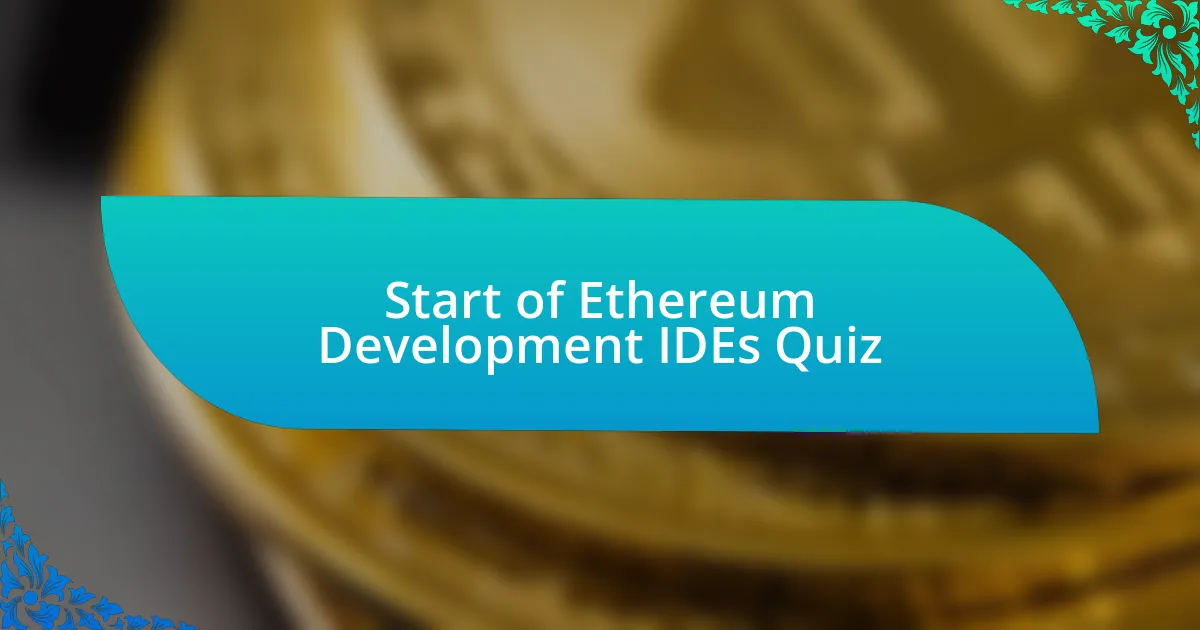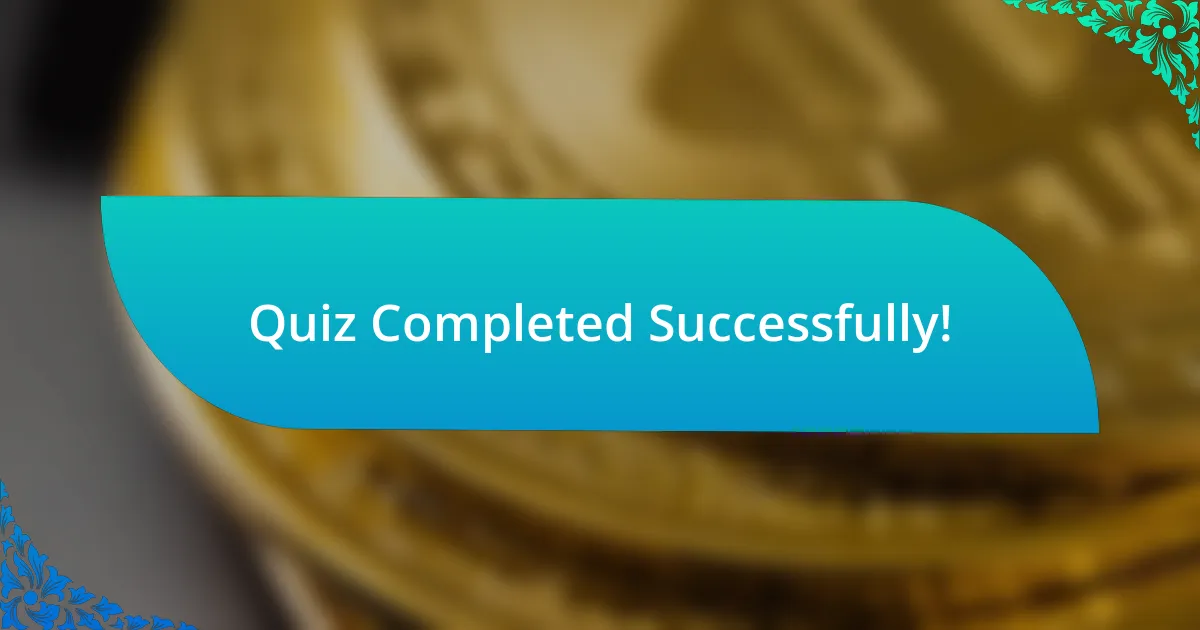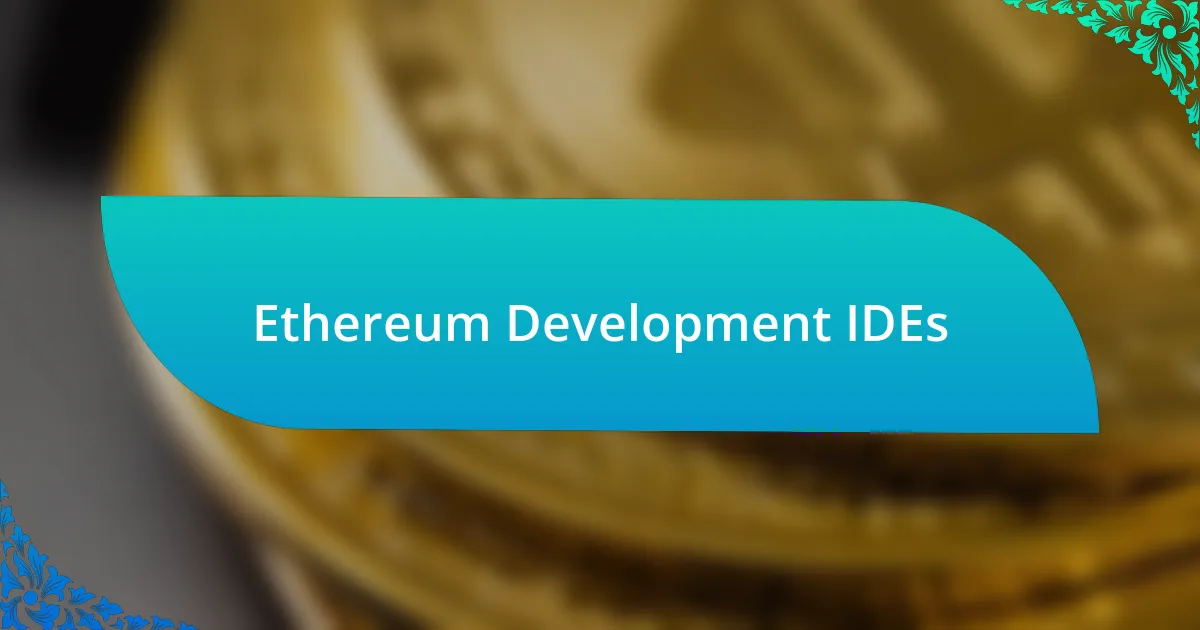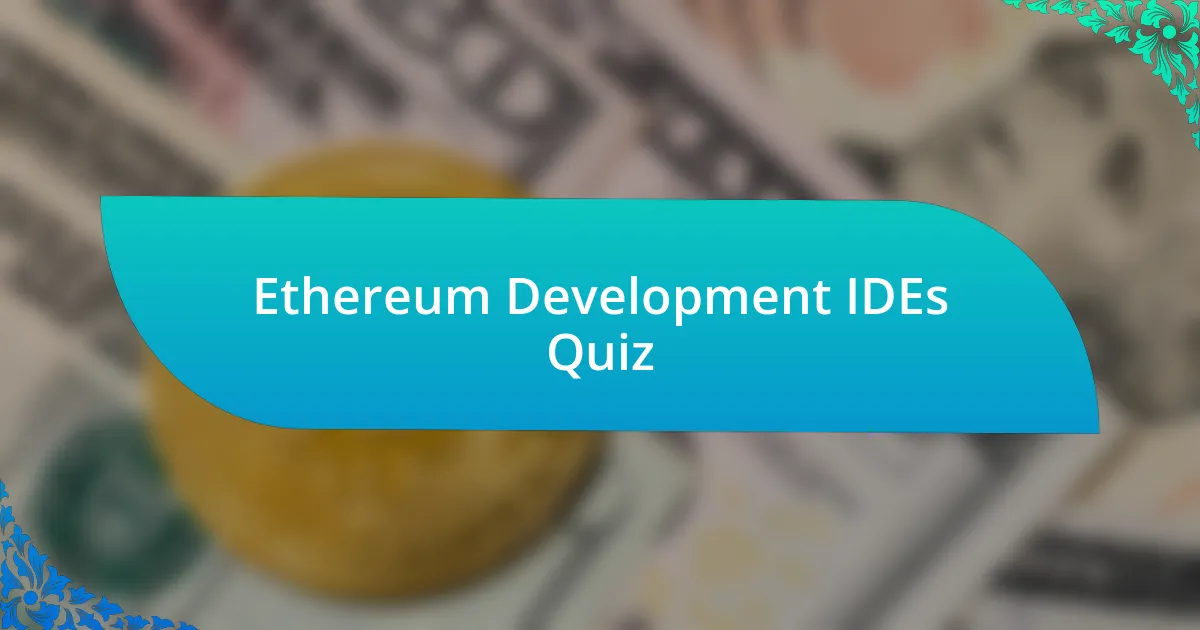
Start of Ethereum Development IDEs Quiz
1. What is Remix IDE?
- Remix IDE is a website for streaming live code tutorials.
- Remix IDE is a game development platform for blockchain games.
- Remix IDE is a powerful, open-source tool that simplifies the process of smart contract development for the Ethereum blockchain.
- Remix IDE is a mobile application for trading cryptocurrencies.
2. What are the core features of Remix IDE?
- Syntax highlighting, intelligent code completion, and real-time feedback.
- Comprehensive database integration, offline development environment, and multi-language support.
- Mobile application development tools, cloud storage options, and game design features.
- Automatic error reporting, graphic design tools, and template generation.
3. How does Remix IDE facilitate smart contract development?
- Remix IDE helps developers create graphics for web applications using HTML and CSS.
- Remix IDE supports game development by providing tools for 3D rendering in the browser.
- Remix IDE allows developers to write, test, and deploy smart contracts directly from a web browser.
- Remix IDE facilitates smart contract development by enabling automated trading in a desktop app.
4. What is the primary programming language used in Remix IDE?
- JavaScript
- Solidity
- Ruby
- Python
5. How does Remix IDE handle plugins?
- Remix IDE uses a robust plugin architecture, allowing developers to extend its functionality with various plugins.
- Remix IDE requires external applications to manage its plugins.
- Remix IDE limits its features to only the core functionalities.
- Remix IDE has a fixed set of tools that cannot be enhanced by plugins.
6. What is the purpose of the File Explorer Panel in Remix IDE?
- The File Explorer Panel compiles Solidity code.
- The File Explorer Panel runs smart contract tests.
- The File Explorer Panel connects to Ethereum networks.
- The File Explorer Panel organizes project files and directories.
7. How does Remix IDE support debugging?
- Remix IDE provides detailed error messages and stack traces, aiding in thorough debugging of Solidity code.
- Remix IDE allows developers to run automated tests on their smart contracts before debugging.
- Remix IDE generates random test cases to simplify the debugging process for developers.
- Remix IDE automatically corrects errors in Solidity code without user intervention.
8. What is the significance of the Plugin Manager in Remix IDE?
- The Plugin Manager in Remix IDE determines the default programming language used for development.
- The Plugin Manager in Remix IDE controls which plugins are activated, allowing developers to customize the environment with required features.
- The Plugin Manager in Remix IDE manages the storage of project files and directories automatically.
- The Plugin Manager in Remix IDE compiles smart contracts written in Solidity directly.
9. How does Remix IDE handle Solidity files?
- Solidity files in Remix IDE are stored under the ‘contracts’ folder in the current workspace.
- Solidity files are compressed and stored in the browser`s cache.
- Solidity files are uploaded to a remote server for storage.
- Solidity files are only stored as text in the console log.
10. What is the Solidity Compiler in Remix IDE?
- The Solidity Compiler manages project files in Remix IDE.
- The Solidity Compiler compiles Solidity files in Remix IDE.
- The Solidity Compiler creates smart contracts from scratch in Remix IDE.
- The Solidity Compiler connects to Ethereum nodes in Remix IDE.
11. How does Remix IDE facilitate the deployment of smart contracts?
- It compiles smart contracts without needing a connected wallet.
- It requires developers to use external tools for deploying smart contracts.
- It allows developers to deploy smart contracts through the Deploy & Run Transactions tab.
- It provides cloud storage for deploying smart contracts.
12. What is the role of the Deploy & Run Transactions tab in Remix IDE?
- The Deploy & Run Transactions tab is used solely for compiling smart contracts before deployment.
- The Deploy & Run Transactions tab only provides a list of plugins available for installation.
- The Deploy & Run Transactions tab is only for viewing transaction history without any functionality.
- The Deploy & Run Transactions tab connects to the network and allows developers to deploy smart contracts by confirming transactions.
13. What is Truffle in the context of Ethereum development tools?
- Truffle is a cryptocurrency wallet for Ethereum.
- Truffle is an Ethereum consensus algorithm.
- Truffle is a development framework for Ethereum.
- Truffle is a user interface for Ethereum mining.
14. What are the key features of Truffle?
- Truffle offers automated testing in both JavaScript and Solidity, supports Mocha and Chai test frameworks, and handles asset pipelines for Ethereum-based projects.
- Truffle provides a cloud-based solution for deep learning applications while managing data security and compliance.
- Truffle is a content management system designed for creating and maintaining websites without coding knowledge.
- Truffle is a mobile app that allows users to socialize and network with others in the tech industry across various platforms.
15. How does Truffle support automated testing?
- Truffle provides automated testing exclusively through custom plugins developed by users.
- Truffle supports automated testing by allowing developers to run tests in both JavaScript and Solidity, using frameworks like Mocha and Chai.
- Truffle helps automate testing through its built-in web server and file management features.
- Truffle supports automated testing by simplifying user interface design for smart contracts.
16. What is the role of plugins in Truffle?
- Truffle supports plugins to enhance its functionality, allowing developers to customize and extend its capabilities.
- Truffle uses plugins to compile Solidity code, streamlining the development process.
- Truffle requires plugins for transaction management, preventing errors during deployment.
- Truffle integrates plugins for managing decentralized storage systems and file uploads.
17. What is Hardhat in the context of Ethereum development tools?
- Hardhat is a specialized programming language for Ethereum smart contracts.
- Hardhat is a cryptocurrency wallet for managing Ethereum assets.
- Hardhat is a powerful Ethereum development environment that allows developers to create, test, and deploy DApps with flexibility and robustness.
- Hardhat is an Ethereum blockchain itself for transaction processing.
18. What are the key features of Hardhat?
- Hardhat is a library for managing Ethereum wallet transactions.
- Hardhat simplifies user interface design for Ethereum dApps.
- Hardhat provides a local Ethereum network for testing and debugging.
- Hardhat exclusively focuses on front-end development for Ethereum.
19. How does Hardhat support debugging?
- Hardhat integrates with external APIs to gather debugging information from remote servers.
- Hardhat offers robust debugging capabilities with detailed error messages and stack traces.
- Hardhat merely provides a logging interface for transaction data during execution.
- Hardhat allows developers to write documentation to track changes in their code.
20. What is the significance of the plugin system in Hardhat?
- The plugin system in Hardhat is designed to prevent integrating third-party tools entirely.
- The plugin system in Hardhat restricts the use of external libraries and frameworks.
- The plugin system in Hardhat enhances versatility and customizes the development environment.
- The plugin system in Hardhat simplifies code syntax and compilation processes.
21. What are the advantages of using Hardhat?
- Hardhat is designed exclusively for frontend web development, ignoring blockchain capabilities.
- Hardhat offers limited customization options, making it inflexible for complex projects.
- Hardhat is highly customizable, has excellent debugging tools, and is actively developed with frequent updates and community contributions.
- Hardhat only supports basic smart contract deployment without any advanced features.
22. What are the disadvantages of using Hardhat?
- Hardhat does not support any plugins or extensions.
- Hardhat provides no debugging tools for developers.
- Hardhat has a steeper learning curve compared to simpler tools.
- Hardhat is only compatible with Ethereum mainnet.
23. What is Ethers.js in the context of Ethereum development tools?
- Ethers.js is a marketplace for trading Ethereum-based assets.
- Ethers.js is a decentralized application that runs on Ethereum.
- Ethers.js is a wallet service for managing Ethereum tokens.
- Ethers.js is a comprehensive and compact Ethereum library ecosystem, making it one of the most popular Ethereum development tools.
24. What are the key features of Ethers.js?
- Ethers.js is a non-compact library that is difficult to use for beginners.
- Ethers.js lacks support for JSON wallets and cannot interact with dApps.
- Ethers.js connects to popular Ethereum nodes and supports various JSON wallets.
- Ethers.js only works with Solidity files and cannot connect to Ethereum nodes.
25. How does Ethers.js support Ethereum nodes?
- Ethers.js only works with the Ethereum mainnet and does not support testnets.
- Ethers.js supports connecting to various Ethereum nodes including MetaMask, Infura API, JSON-RPC, Alchemy, or Etherscan.
- Ethers.js cannot interact with wallets and relies solely on hardcoded addresses.
- Ethers.js is limited to local Ethereum nodes and cannot connect to external services.
26. What is Embark in the context of Ethereum development tools?
- Embark is a decentralized storage platform.
- Embark is a programming language for Ethereum.
- Embark is a development framework for Ethereum.
- Embark is a blockchain consensus algorithm.
27. What are the key features of Embark?
- Embark does not support decentralized storage systems.
- Embark requires manual deployment of contracts.
- Embark is limited to Ethereum mainnet only.
- Embark automatically tracks and redeploys contracts.
28. How does Embark support contract deployment?
- Embark automatically deploys contracts to various networks and keeps track of them, redeploying them as needed.
- Embark requires manual submission of contracts for each deployment to the blockchain.
- Embark only supports contract deployment on the mainnet without options for testnets or private networks.
- Embark does not provide any monitoring options for deployed contracts after deployment.
29. What is the role of MetaMask in Ethereum development?
- MetaMask serves exclusively as a debugging tool for smart contracts.
- MetaMask is a popular browser-based Ethereum wallet that can be used to interact with dApps on the Ethereum network.
- MetaMask is a network monitoring tool for Ethereum developers.
- MetaMask is used to compile Solidity code in Ethereum development.
30. What is the primary function of MetaMask?
- The primary function of MetaMask is to serve as a token wallet and dApp gateway, allowing users to interact with decentralized applications.
- The primary function of MetaMask is to host Ethereum nodes for enhanced blockchain connectivity.
- The primary function of MetaMask is to compile Solidity code and deploy smart contracts.
- The primary function of MetaMask is to provide cloud storage solutions for dApps and tokens.

Quiz Completed Successfully!
Congratulations on completing the quiz on Ethereum Development IDEs! You’ve just taken an important step in enhancing your understanding of the tools that shape smart contract development. Completing this quiz has likely deepened your appreciation for the various Integrated Development Environments (IDEs) available to Ethereum developers. Each IDE comes with unique features, which can significantly improve your coding efficiency and project management skills.
Throughout the quiz, you explored popular IDEs like Remix, Truffle, and Hardhat. You may now have insights into how these tools streamline the development process and enhance debugging capabilities. Understanding these concepts is crucial, as they form the backbone of efficient smart contract development and deployment on the Ethereum blockchain.
We invite you to continue your learning journey! Check out the next section on this page for more in-depth information about Ethereum Development IDEs. This resource will expand your knowledge and provide practical insights that can elevate your development skills. Enjoy the process of learning, and let’s dive deeper into the world of Ethereum together!

Ethereum Development IDEs
Understanding Ethereum Development IDEs
Ethereum Development IDEs (Integrated Development Environments) are tools designed specifically for developing smart contracts and decentralized applications (dApps) on the Ethereum blockchain. These IDEs provide features such as code editing, debugging, and deployment directly to Ethereum networks. They simplify the development process, allowing developers to focus on building applications with less complexity regarding the technical intricacies of the Ethereum protocol.
Key Features of Ethereum IDEs
Ethereum IDEs typically include features like syntax highlighting for Solidity (the programming language for Ethereum smart contracts), auto-completion for code, integrated testing frameworks, and support for deploying contracts to networks like mainnet or testnets. Additionally, they often allow connection to Ethereum clients, enabling real-time interaction with the blockchain. This combination of features fosters an efficient development environment that streamlines the entire workflow from writing to deploying code.
Popular Ethereum Development IDEs
Some of the most popular Ethereum Development IDEs include Remix, Truffle Suite, and Hardhat. Remix is a web-based IDE known for its user-friendly interface and powerful debugging tools. Truffle Suite offers a comprehensive environment for writing, testing, and deploying smart contracts, along with a suite of development tools. Hardhat is a flexible framework that enhances the development experience by providing local testing and debugging capabilities.
Choosing the Right IDE for Ethereum Development
Selecting the appropriate Ethereum IDE depends on several factors including the project’s specific requirements, the developer’s proficiency, and the ecosystem preferences. For beginners, Remix is highly recommended due to its simplicity and ease of access. For more complex projects, Truffle or Hardhat may be better choices due to their extensive features and capabilities for managing larger codebases.
Future Trends in Ethereum Development IDEs
The future of Ethereum Development IDEs is expected to focus on improved user experience and enhanced functionalities. Trends may include better integration with emerging blockchain technologies, increased support for different programming languages, and collaborative features enabling multiple developers to work simultaneously. Additionally, IDEs may implement more robust security tools adaptable to the evolving landscape of blockchain vulnerabilities.
What are Ethereum Development IDEs?
Ethereum Development IDEs are integrated development environments specifically designed for building and deploying smart contracts on the Ethereum blockchain. These tools provide essential features such as code editing, debugging, and testing capabilities tailored for Ethereum programming languages like Solidity. Examples include Remix, which operates in a web browser and offers real-time compilation, and Truffle, which offers a suite of tools to assist with testing and deployment, demonstrating their importance in the Ethereum development ecosystem.
How do you use Ethereum Development IDEs?
To use Ethereum Development IDEs, developers typically start by selecting an IDE like Remix or Truffle. They can create a new project and write smart contracts using Solidity. Once the code is written, the IDE will often include features to compile the contract, allowing the developer to check for errors. After compilation, developers can deploy the contract to a test network or the main Ethereum network directly from the IDE, ensuring a streamlined development process.
Where can you find Ethereum Development IDEs?
Ethereum Development IDEs can be found online. Popular options like Remix are accessible via their official website without any installation required. Other IDEs like Truffle can be downloaded from GitHub or through Node Package Manager (npm). Additionally, many development environments are available as plugins for code editors like Visual Studio Code, making them easily integrable into existing setups.
When were Ethereum Development IDEs first introduced?
Ethereum Development IDEs were first introduced following the launch of the Ethereum platform in 2015. Remix, one of the earliest IDEs, began development around the same time to facilitate smart contract development. Over the years, as the Ethereum ecosystem grew, various other IDEs emerged, evolving to meet developers’ needs for better tools and integration.
Who typically uses Ethereum Development IDEs?
Ethereum Development IDEs are primarily used by blockchain developers, software engineers, and programmers who are focused on decentralized application development. They cater to both experienced developers familiar with blockchain technology and newcomers seeking to learn how to create and deploy smart contracts on Ethereum. Organizations building blockchain solutions also utilize these tools for efficient development workflows.

